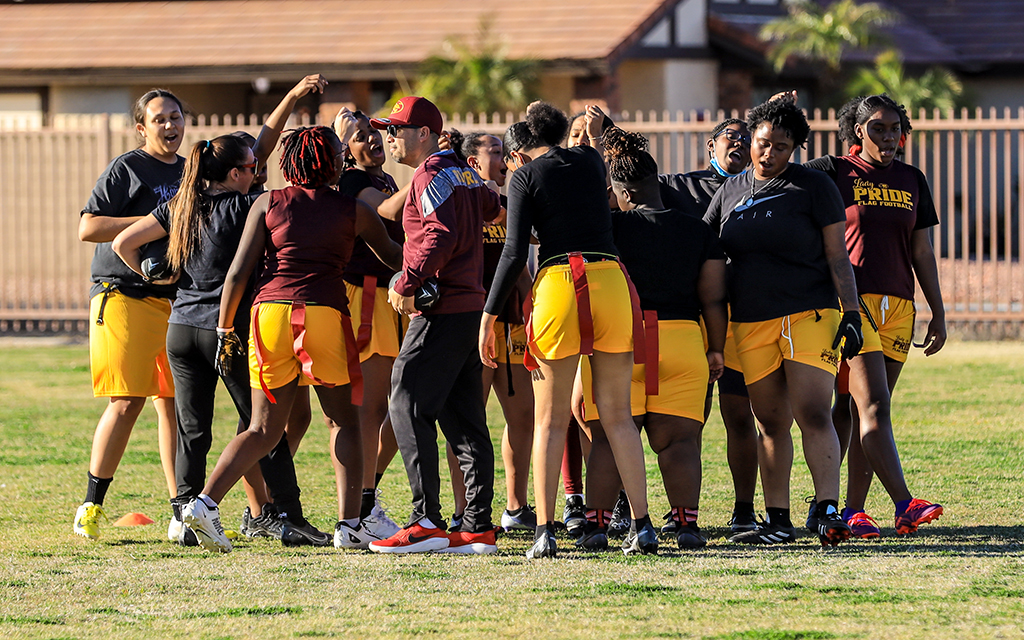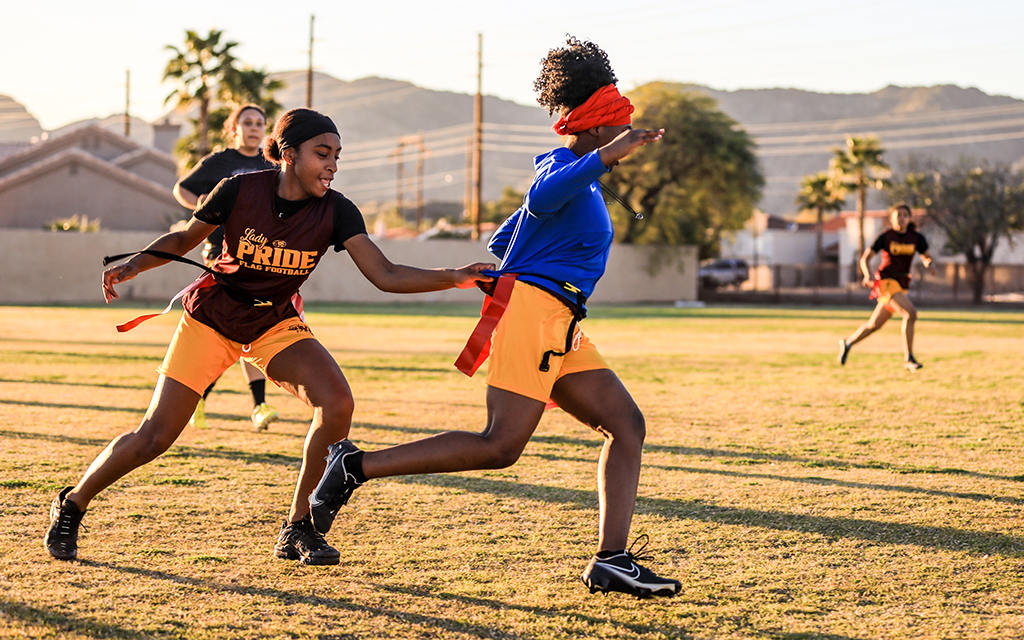TEMPE – This time last year, the Arizona Interscholastic Association was preparing to make a groundbreaking announcement: Girls flag football was coming to the Valley. Now, after a successful inaugural season, a new message is being delivered: the newly sanctioned high school sport is looking to expand its reach.
Flag football has seen massive growth across the country with eight states participating in girls flag football, including Arizona, and also internationally with the International Olympic Committee approving the sport as part of the official program for the 2028 Olympic Games in Los Angeles.
Given the positive reviews in the Valley, the interest and growth are projected to increase rapidly, presenting female athletes an equal opportunity to compete on the gridiron and with a safer option from contact football.
“The girls deserve the sport, it’s the number one sport, football’s the number one sport in America and Arizona, by a wide margin, and the fact that we have denied it to girls for a hundred years, it doesn’t say a lot good for us as a school system,” said Hamilton girls flag football coach Matt Stone, whose team finished as a semifinalist in the 6A state playoffs.
“We are rectifying that. We are building these opportunities and everyone needs to try and get on board, and support the girls.”
Stone entered the 2023 season with a couple of girls flag football seasons on his resume before the sport was sanctioned. He explained that with the AIA’s support, girls flag football has fixed a critical piece in making it competitive against other sports.
“In the past, the biggest difficulty was convincing a girl, from another sport, to maybe take off one season of club in order to play flag football,” Stone said. “There was no point. Why would she take off three months, from club soccer, basketball, or volleyball to play a sport that was a dead end? Once the AIA sanctioned the sport, it gave us legitimacy.”

Flag football coaches strategize for the upcoming season, discussing plans to add more girls teams and target junior high schools to ensure the sport’s continued growth. (File photo by Susan Wong/Cronkite News)
Mountain View High School took home the first 6A state championship with a 10-7 win over Mountain Ridge on Nov. 4. Now, with the title game in the rear view, the top priority for the AIA and flag football coaches is to expand the sport within the state and at the collegiate level.
The AIA fielded 54 teams from two conferences for its inaugural girls flag football season, but coaches want to see more teams in 2024.
“The number one thing we want to continue to focus on is expanding the number of schools that are playing. I think we have already added 30 for next year, and they (AIA) believe we will see about 10 to 15 more before the year starts,” Stone said. “We also want to start targeting junior high schools and of course the big one, which is getting Arizona colleges to offer opportunities.”
Mountain Ridge coach Whitney Warmus shared Stone’s desire to expand the sport to other schools, while at the same time creating opportunities and becoming more inclusive for high school students who already have an existing varsity team.
“I think there are roughly 50-60 teams in the state of Arizona right now. I hope that number grows, and me personally, I want to see a junior varsity team,” Warmus said.
Creating a junior varsity division could become a reality in the future. Mountain View coach Jesus Arzaga had around 60 athletes try out for the varsity team. While there was a surplus of interested players, Stone said resources prevented any expansion ahead of this season.
“Nobody had enough uniforms. It takes four sets of uniforms to have a varsity and JV team,” said Stone, who added that offseason planning will involve finding ways to fund uniforms.
More teams and competition levels will present more opportunities, but of course there is another issue aside from resources that the AIA will need to address: scheduling.
“The bigger issue we are having with JV is, when will the games be played? This really goes back to the most critical debate, which is does this sport belong in the fall or the spring,” Stone said. “I mean (in) Arizona, we played this sport in spring for 17 years, and then the AIA moved it to the fall. There are some advantages to both, but I am still in the camp that this is a spring sport.
“One of the reasons why is because of JV. Typically a JV game would be played before a varsity game, but if a girls varsity team is having to play on a Thursday and is having to play on the same field as a JV boy’s team, there’s no space for JV girls. I don’t accept the idea that JV (girls) only gets to play on Tuesdays, because that is not going to allow enough opportunities to play … 80 or 90 percent of a varsity schedule, like any other sport would do.”
A large part of incorporating JV teams is solidifying the varsity schedule. Mountain Ridge had to play four regular-season games in one week on four different days.
Both 6A finalists had to travel away for every game in the playoffs as the lower seeds. Mountain View, however, was tabbed the finals host and had the privilege of playing at home for the title.
“We’re playing two games a week and I’m tired, as the coach, and I am not even playing the game,” Warmus said. “Especially in the playoffs, it’s taking a toll mentally and physically on all of them (players).”

Arizona’s girls flag football coaches emphasize the importance of offering equal opportunities to female athletes in the state’s school system. (File photo by Susan Wong/Cronkite News)
As for other adjustments the AIA could make this offseason, Arzaga expressed some concerns with the rules. Some rules could be more specific, particularly in the area of blocking, he says.
“There are always things that are going to have to get better,” Arzaga said. “They’re going to eventually look at the rule book a little bit, and kind of dissect a couple of things.”
Despite a few fixable issues, the AIA’s first girls flag football season was a special opportunity for players, coaches and supporters across Arizona. The competition featured a diversity of athletes, and non-athletes, playing a sport that has been denied to girls for too long.
“It was really cool to have everyone come from different sports, or maybe not a sport at all,” Mountain Ridge co-caption Emma Johnson said. “We came from different areas of life, with different hobbies, and all came together on one team.”
“We have been wanting to do powderpuff, so the fact that this (is) one step better is just awesome and we can be the start of it (girls flag football),” added Madison Green, co-captain and teammate of Johnson.
Despite being on opposite sides of the sideline, Warmus, Arzaga and Stone can all agree that expansion is most important to the sport’s longevity. With the sport already taking the right steps toward growth, Stone had one message for school administrators.
“Don’t wait, don’t say we will get there in one or two years, because what is going to end up happening is, your girls who want to play this sport are going to leave, they are not going to stay. If you don’t give them an option to play, they are going to go to a district that offers the sport,” Stone said. “If you want to be a part of the movement, you need to offer it now, and not wait two or three years as we heard some large districts are likely to do.”
For many sports fans in America, watching and playing football is a tradition. To see the sport becoming more inclusive while staying true to the game and providing a necessary upgrade from powderpuff games leaves a world of potential.
“It’s not your powderpuff kind of thing. These girls are out here competing, they are true athletes,” Arzaga said. “This is true football from what I feel like, there’s just no tackling.”

